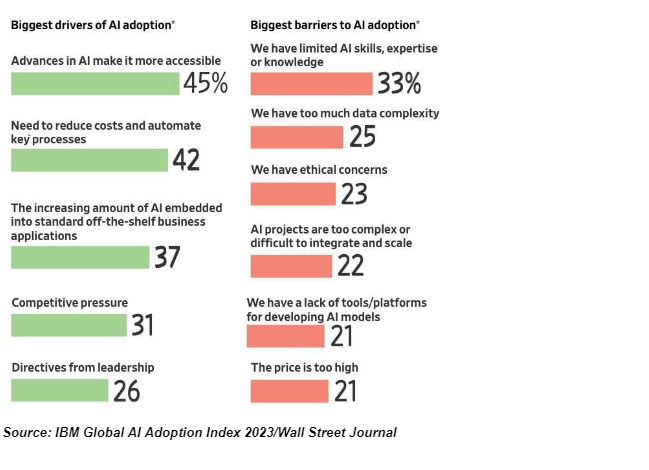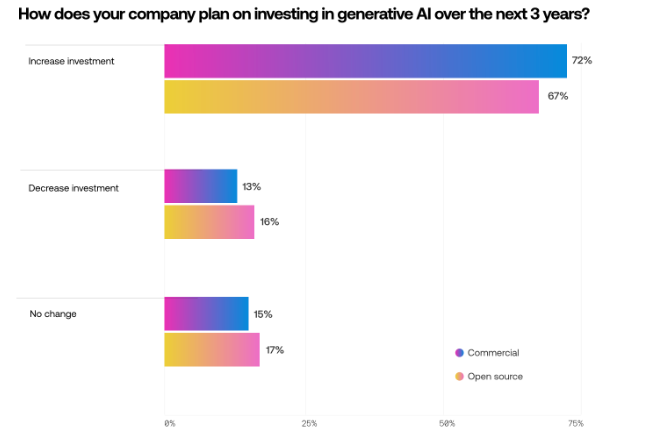The Biggest Drivers and Barriers to AI Adoption for Businesses
In the fast-evolving landscape of technology, Artificial Intelligence (AI) stands out as a revolutionary force shaping the future of business operations. Companies worldwide are exploring AI’s potential to streamline processes, cut costs, and gain a competitive edge. However, the journey to AI adoption is fraught with challenges that can hinder its widespread implementation. This article delves into the biggest drivers and barriers to AI adoption in businesses, providing insights into how organizations can navigate this complex terrain.

Biggest Drivers of AI Adoption
Advances in AI Make It More Accessible (45%)
AI adoption has surged due to remarkable advancements in the technology, making it more accessible than ever. Innovations in machine learning, natural language processing, and computer vision have democratized AI, allowing even small businesses to benefit. These advancements have lowered entry barriers, enabling companies to implement AI solutions without requiring extensive technical expertise. As AI capabilities grow more robust, its adoption continues to expand across various industries.
Need to Reduce Costs and Automate Key Processes (42%)
In today’s competitive, high interest-rate market, cost reduction and process automation are critical for business survival and growth. AI offers unparalleled opportunities to automate routine tasks, optimize operations, and enhance efficiency. From customer service chatbots to predictive maintenance in manufacturing, AI-driven automation can lead to significant cost savings and improved productivity. Businesses are increasingly turning to AI to streamline workflows, reduce manual intervention, and achieve operational excellence.
The Increasing Amount of AI Embedded into Standard Off-the-Shelf Business Applications (37%)
Another pivotal driver is the integration of AI into standard off-the-shelf business applications. Many enterprise software solutions now come with built-in AI capabilities, allowing businesses to leverage advanced analytics, machine learning, and intelligent automation without developing custom AI solutions from scratch. This integration simplifies the adoption process, making it easier for businesses to incorporate AI into their existing workflows and systems.
Competitive Pressure (31%)
The pressure to stay competitive is a significant motivator for AI adoption. Companies are keenly aware that leveraging AI can provide a strategic advantage, enabling them to offer superior products and services, optimize customer experiences, and make data-driven decisions. Organizations that fail to adopt AI risk falling behind their competitors, losing market share, and missing out on growth opportunities. The competitive landscape compels businesses to embrace AI to remain relevant and thrive.

Source: Scale AI 2024 AI Readiness Report
Directives from Leadership (26%)
Leadership directives play a crucial role in driving AI adoption. Visionary leaders recognize the transformative potential of AI and actively champion its implementation within their organizations. By setting clear AI adoption goals and fostering a culture of innovation, leaders can motivate their teams to explore and embrace AI solutions. Leadership support ensures that AI initiatives receive the necessary resources and strategic focus, accelerating their successful deployment.
Biggest Barriers to AI Adoption
Limited AI Skills, Expertise, or Knowledge (33%)
The most significant barrier to AI adoption is the lack of skills, expertise, and knowledge in AI. Many organizations struggle to find and retain qualified AI professionals who can develop, implement, and maintain AI systems. This skills gap hampers the ability to execute AI projects effectively and fully capitalize on AI’s potential. Upskilling employees with fundamental AI skills is essential to bridge this gap. Purple AI offers comprehensive employee upskilling services designed to equip your workforce with the necessary AI expertise, empowering your organization to overcome this barrier and reap the rewards that AI technology can offer.
Data Complexity (25%)
Managing complex data is a formidable challenge that hinders AI adoption. Organizations often deal with vast amounts of data from various sources, making it difficult to clean, integrate, and analyze. Data quality issues and siloed data can impede the development of accurate and reliable AI models. To address this challenge, businesses need robust data management strategies and tools that facilitate seamless data integration and analysis.
Ethical Concerns (23%)
Ethical concerns surrounding AI use are another notable barrier. Issues related to data privacy, bias in AI algorithms, and the potential impact on jobs raise ethical questions that organizations must address. Developing transparent, fair, and accountable AI systems is crucial to gaining stakeholder trust and ensuring ethical AI adoption. Establishing ethical guidelines and fostering a culture of ethical AI practices can help mitigate these concerns.
Complexity of AI Projects (22%)
The complexity of AI projects and difficulties in integration and scaling are substantial barriers. AI initiatives often require significant resources, time, and technical expertise to implement. Ensuring that AI solutions integrate seamlessly with existing systems and scale effectively to meet business needs is a major challenge. Organizations can benefit from strategic planning, phased implementation, and collaboration with experienced AI partners to navigate these complexities.
Lack of Tools/Platforms for Developing AI Models (21%)
The absence of adequate tools and platforms for AI model development is also a hindrance. Developing AI models from scratch requires specialized software, hardware, and frameworks that may not be readily available to all businesses. Investing in or partnering with providers of advanced AI development platforms can help organizations access the necessary tools to create and deploy AI models effectively.
High Costs (21%)
High costs associated with AI adoption are a notable barrier. Developing, implementing, and maintaining AI systems can be expensive, particularly for small and medium-sized enterprises. However, the long-term benefits of AI, such as cost savings and increased efficiency, often outweigh the initial investment. Businesses can explore cost-effective AI solutions and leverage cloud-based AI services to minimize upfront costs and achieve a positive return on investment
Empower Your Workforce with Upskilling from Purple AI
While the drivers of AI adoption are compelling, the barriers are equally formidable. By understanding these factors and addressing the challenges head-on, businesses can successfully navigate the path to AI adoption. Upskilling employees with fundamental AI skills is a critical step in overcoming the skills gap and ensuring successful AI implementation. Purple AI’s employee upskilling services are designed to empower your workforce with the expertise needed to leverage AI effectively. Embrace the future of business with AI and get in touch with Purple AI today for a free consultation.
Source of statistics: IBM Global AI Adoption Index 2023 / Wall Street Journal
